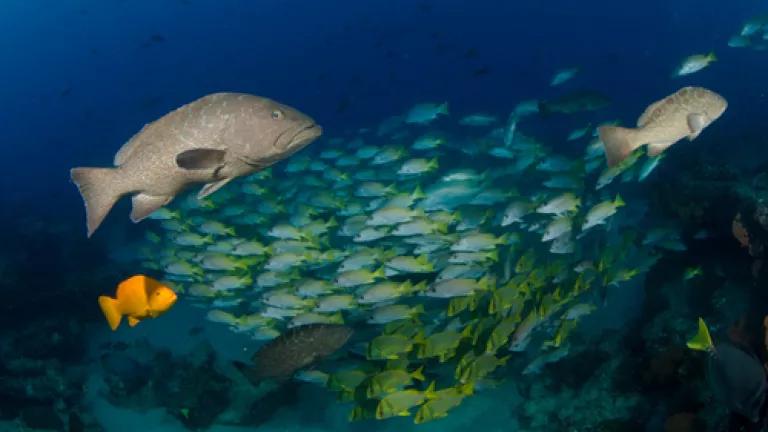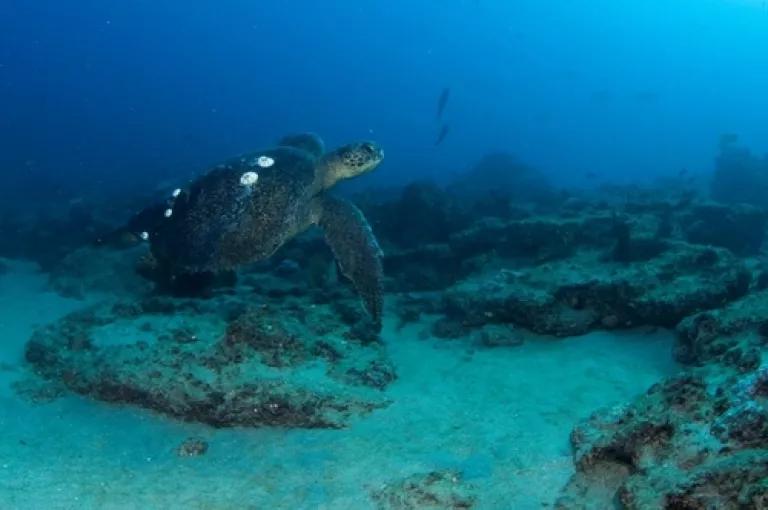
Scientists from the Scripps Institute of Oceanography at UC San Diego released a new study demonstrating that the coral reef and marine ecosystem at Cabo Pulmo National Marine Park, in Baja California, is uniquely healthy among other marine protected areas in the Gulf of California. In fact, they call it the “most robust marine preserve in the world.” Cabo Pulmo is a shining example of successful conservation on the local, national and international levels. Yet, it is now the target of a proposed mega-tourism complex which threatens to undo all of the progress these scientists have documented.
Photo: courtesy of Octavio Aburto-Oropeza, iLCP
The study’s authors found that, between 1999 and 2009, the overall biomass in Cabo Pulmo’s waters increased 463 percent. The biomass of top predators –a key indicator of a reef’s health– increased 11 times, while the biomass of carnivores increased four times. Octavio Aburto-Oropeza, lead author of the study and postdoctoral researcher at Scripps, said “no other marine reserve in the world has shown such a fish recovery.” In sharp contrast the biomass in the other marine protected areas and open access areas that were surveyed during the same period showed no significant increase. What is the reason for Cabo Pulmo’s unparalleled growth? The scientists attribute the Park’s booming fish populations to the size of the protected "no-take" area and to the local community’s commitment to enforcing the strict “no-take zone” measures.
This study is a bright sign of hope for the earth’s oceans and marine wildlife, which are facing threats on a variety of fronts. Climate change’s impacts on oceans are only starting to be understood. Science magazine reported that 2010 was perhaps the worst year ever for the Caribbean’s coral reefs, which suffered sky-high rates of bleaching from abnormally warm waters. More recently, century-old coral reefs in the Florida Keys died due to an unusual streak of cold weather. Oceans absorb roughly a quarter of all carbon dioxide emissions and have become more acidic as increasing amounts of greenhouse gases are emitted. Whales face threats from commercial whaling, military sonar and coastal industrialization. The New York Times reported on the dire situation of Atlantic bluefin tuna because of catastrophic overfishing. Anywhere from 26 - 73 million sharks are killed annually for their fins. Fortunately, a number of countries and states have taken action by prohibiting the sale, trade and distribution of shark fins.
Thirty years ago, Cabo Pulmo’s coral reef also suffered from rampant overfishing. The local community successfully asked the government to give the reef protected status, which was granted in 1995. The 17,564 acre preserve became a National Marine Park in 2000, a UNESCO World Heritage Site in 2005 and a Ramsar International Wetlands Site in 2008.

Photo: courtesy of Octavio Aburto-Oropeza, iLCP
This new study clearly demonstrates that marine ecosystems have a surprising and astonishing ability to bounce back – when given the chance. Co-author of the study and Explorer-in-Residence at National Geographic, Enric Sala, remarked that he “could never have dreamt of such an extraordinary recovery of marine life at Cabo Pulmo.”
All of this progress could be threatened, however, if Spanish developer Hansa Urbana has its way and builds a mega-tourism complex, called Cabo Cortés, nearby. The company is proposing to construct a Cancun-style resort: hotels and housing units totaling 30,000 rooms, two 27-hole golf courses, a private jet strip, a 490-slip marina, desalination and water-treatment plants, some 2 million square feet of office and commercial space, and related infrastructure on the property adjacent to and north of Cabo Pulmo. It isn’t a stretch to say that this complex would devastate the booming marine life inside the Park’s borders.
The good news is that this new study is hard evidence about the critical need to protect Cabo Pulmo from this irresponsible proposal. Local and international groups are campaigning against Cabo Cortés. The Mexican Government only has to uphold its 1995 protection decision and reject Hansa Urbana’s project, and then work with local communities on an environmentally sustainable development plan that indefinitely safeguards this thriving coral reef and the communities who worked so hard to protect it.
To send a letter to Mexican authorities asking them to reject Cabo Cortés, take action here.
To see more photos of Cabo Pulmo National Marine Park’s wildlife, view the “Cabo Pulmo” gallery at www.octavioaburto.com.
The study: Aburto-Oropeza O., Erisman B., Galland G.R., Mascareñas-Osorio I., Sala E., et al. (2011) “Large Recovery of Fish Biomass in a No-Take Marine Reserve;” PLoS ONE 6(8): e23601. Doi:10.1371/journal.pone.0023601.

